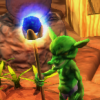
I've incorporated the texture "splatting" that I talked about a few posts ago, although I still need to hammer out the method for creating the art for coastlines and shorelines, since just doing an alpha blend onto the water of a flat splat kind of looks like crap. The ground splats in this shot are quickies, test of concept art that need more work. However, even given that fact, it still looks pretty good. Not quite the look and feel I'm trying for, but okay. In the above shot, I render a base layer, but with better splats and a denser grouping I can do away with that later and just do splats. I don't really like that background sandy texture anyway.
Today I worked on cliffs. I've done cliffs before, but today's efforts represent a technique I've been working on to speed the process and obtain better results. I'm working on a more lengthy journal post to describe the process. The short form is that Sculptris is kind of awesome.
Things are picking up in pace lately with this thing, as I get the rust oiled out of the old machine. In many ways, I'm doing better work than my old Golem project, but in other ways (mostly speed) I still need to improve. At any rate, I'm having fun with it again. Woot.




